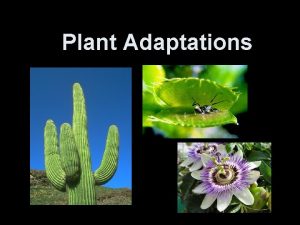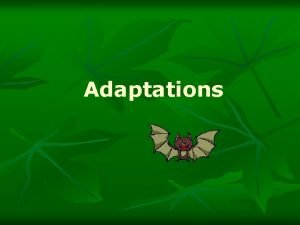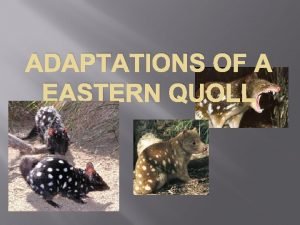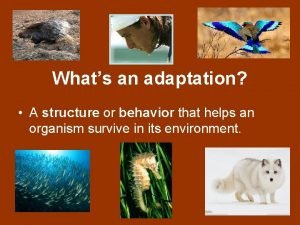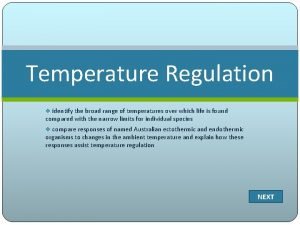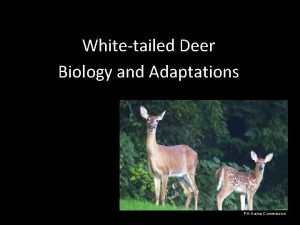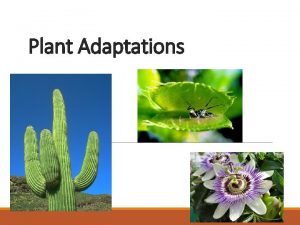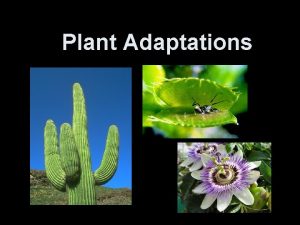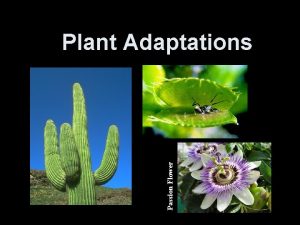Adaptations Types of Adaptations Structural adaptations Physiological adaptations










- Slides: 10

Adaptations

Types of Adaptations • Structural adaptations • Physiological adaptations • Behavioural adaptations

Structural Adaptations • A structural adaptation refers to a part of an organism's body that better assists survival to a particular niche the organism inhabits • E. g. : thick fur on a polar bear allows it to cope with the extreme cold • E. g. : sharp thorns of a thistle which keep it from being eaten

Physiological Adaptations • Physiological adaptations are those that help to regulate a function of the body that better assists survival. It is a physical, biochemical ability that makes an organism better suited to its environment. • Physiological adaptations are generally internal, involving some part of the organism

Physiological Adaptations • E. g. : the amount of melanin produced in the skin serves as a protection against UV radiation • E. g. : production of a special fat that animals use as food during hibernation • E. g. : venom produced by a snake

Behavioural Adaptations • Behavioural adaptations are something the animal does while interacting with the environment to better survive. • E. g. : most desert animals are nocturnal • E. g. : tunnelling by Bandicoots to avoid the heat of day

Quiz: Adaptations • What type of adaptations are these? 1. The Australian mulga tree has a unique way of collecting water. Its tiny leaves grow upward, forming a series of funnels that send rain water along the branches and down the trunk to the ground, where the roots are concentrated close to the base of the tree.

Quiz: Adaptations • What type of adaptations are these? 2. Many Eucalypt trees limit water loss through their leaves by having waxy leaves. 3. Some Eucalypt trees have leaves that hang downwards with their edges facing east-west to minimise exposure to the sun. 4. Some plants only open their leaf pores at night when it is cool and water loss from leaves is low.

Quiz: Adaptations • What type of adaptations are these? 5. Fat increases body heat, so Wooley’s False Antichinus concentrates its’ body's fat in one place – the tail. 6. The Thorny Devil has a body that channels raindrops directly into its mouth when rain falls. 7. The leaf-nosed bat has a leaf nose to better emit and receive echo location signals

Quiz: Adaptations • What type of adaptations are these? 8. The Mountain Pygmy-possum lives in the alpine areas of Australia. During winter, it goes into hibernation under the snow and wakes up in spring. 9. The water-holding frog spends most of the year under the ground in Australian desert areas. When it rains, they emerge to lay their eggs in puddles. The eggs hatch within days and the tadpoles develop quickly, before the water dries out.
 Behavioural adaptations of plants
Behavioural adaptations of plants Stroke volume pdhpe
Stroke volume pdhpe Beaver physiological adaptations
Beaver physiological adaptations Physiological adaptation examples
Physiological adaptation examples Elephant behavioral adaptations
Elephant behavioral adaptations Tasmanian devil physiological adaptations
Tasmanian devil physiological adaptations Whats a structural adaptation
Whats a structural adaptation Red kangaroo behavioural adaptations
Red kangaroo behavioural adaptations 4 types of physiological measurements
4 types of physiological measurements Deer structural adaptations
Deer structural adaptations Manatee structural adaptations
Manatee structural adaptations
